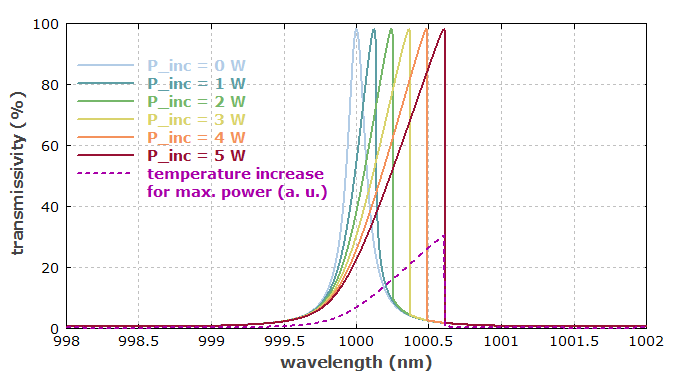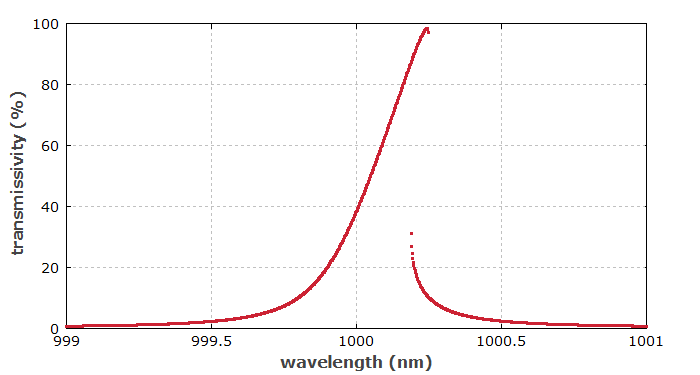RP Coating – Advanced Software for
Designing Optical Multilayer Structures
| Overview | Purpose | Model | Interface | Demos | Versions |
Demo File: Etalon with Thermal Effects
The high flexibility of our software allows one to do quite sophisticated calculations. As an example, we analyze a case where the optical power in a structure leads to heating, while the resulting temperature change affects the optical behavior, thus also the heating power. One needs to iteratively calculate a steady state of the system.
We consider a monolithic etalon, consisting of two Bragg mirrors around a thick dielectric spacer medium, which exhibits some absorption losses. That design is described as follows:
d_units: nm
l_units: nm
l_Bragg := 1000 { Bragg wavelength }
N_Bragg := 4 { number of layer pairs }
d_sp := 0.1 mm / d_units { thickness of spacer }
n_sp := 1.5 { refractive index of spacer (for T = 0) }
n_i_sp := 1e-6 { imaginary component of refractive index of spacer }
dndT_sp := 3e-4 { temperature coefficient of spacer }
dTdP := 35 { thermal resistance in K/W }
beam from superstrate
substrate: air
for j := 1 to N_Bragg do
begin
* SiO2, l/4 at l_Bragg
* TiO2, l/4 at l_Bragg
end
* (n = n_sp + i * n_i_sp), d = d_sp
spacer := nolayers()
for j := 1 to N_Bragg do
begin
* TiO2, l/4 at l_Bragg
* SiO2, l/4 at l_Bragg
end
superstrate: air
In order to take into account effect of heating of the spacer layer, which is caused by absorption of light, we first define a function to set a certain device temperature:
set_T(T) := set_n(spacer, n_sp + dndT_sp * T + i * n_i_sp)
Then we define a function which iteratively calculates a self-consistent state of the system:
T_h(l, P_inc, var dT) :=
{ Transmissivity for wavelength l and incident power P_inc,
taking into account the heating of the spacer medium.
The temperature increase is returned as dT;
its initial value is also used. }
begin
global dTdP;
const T_tol = 1e-4, dT_tol = 1e-3, max_N = 500;
var T, N, T_l, dT_l, ok;
set_T(dT);
T := T(l); { calculate transmission for the given temperature }
N := 0;
repeat
var P_dis;
inc(N);
T_l := T; { last transmission value }
dT_l := dT; { last temperature change }
P_dis := P_inc * (1 - T - R(l));
dT := P_dis * dTdP;
dT := 0.5 (dT + dT_l);
set_T(dT);
T := T(l); { recalculate for the new temperature }
ok := abs(T - T_l) < T_tol and abs(dT - dT_l) < dT_tol;
until ok or N = max_N;
if ok then T else -1;
end
This version is not yet perfect in terms of convergence to the steady state; therefore, a demo file supplied with the software has a somewhat more refined version which uses variable damping of the temperature evolution.
Now we can display the transmissivity as a function of the wavelength for different incident optical powers, and the temperature increase for the highest power value:
diagram 1: "Power-dependent Transmissivity Profile" x: 998, 1002 "wavelength (nm)", @x y: 0, 100 "transmissivity (%)", @y frame hx hy P_inc_max := 5 ! dT := 0 f: 100 * T_h(x, P_inc, dT), width = 3, step = 1, maxconnect = 1, for P_inc := 0 to P_inc_max step 1, ["P_inc = ", P_inc:d3:"W"], color = color_I(0.1 + 0.9 * P_inc / P_inc_max) ! P_inc := P_inc_max ! dT := 0 f: (T_h(x, P_inc, dT); dT) * 10, color = magenta, width = 3, style = fdashed, step = 1, "temperature increase\\for max. power (a. u.)"

One can see that the transmission peaks of the etalon become more and more asymmetric as the incident power is increased. This is because the resonantly enhanced power causes increased heating, which shifts the resonant towards longer wavelengths. (Strictly speaking, this effect is caused both by an increase of refractive index and thermal expansion of the spacer, but for simplicity we can model both effects combined by using an increased effective temperature coefficient of the refractive index.)
A second diagram shows what happens if we scan the resonance in both directions for the highest incident power:

When starting at short wavelengths, one can obtain high transmission around 1000.25 nm, where resonance is obtained only due to the strong heating. However, when starting at long wavelengths, the system stays in a low-transmission state for the same wavelength of 1000.25 nm. Such bistable behavior is often observed in such systems. In our example case, it disappears when we reduce the number of Bragg layer pairs per mirror from 4 to 3.
